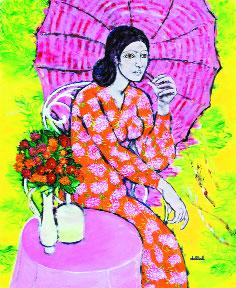Artist Maite Delteil’s series of paintings from the 1960s features women who are free to roam the terrain of their imagination without boundaries. By Team Viva
Being brought up at the countryside of France, artist Maite Delteil’s context in her paintings was relatively conservative — one where women were not allowed the freedom that they could access today. As the Art Alive gallery presents the artist’s collection of 20 to 30 of her artworks from the 1960s, titled The Yellow Room, Delteil talks about how these works came into existence when she was young, exploring the depths of her thoughts.
Her series of paintings have been seen as a reminder of freedom and intimacy that is primarily reserved for oneself, in private chambers. The domesticity that one views in her paintings is not the domesticity that is traditionally ascribed to women as their responsibility, but one that Virginia Woolf would have approved of — women in rooms of their own.
Empowered by travel and time spent in Spain and Greece, Delteil transcended her circumstances to grow as an artist, and marry the man of her choice, Indian artist Sakti Burman, to her family’s displeasure.
When a friend asked the artist that why there are only women in her paintings of the 60s and why generally is there a single woman in each of it?
She replied, “In the 60s, the social life in France was a bit conservative. My father had rejected me from the family when I married my Indian friend. It was my unconscious thought that women have to solely find their place in the society, without anyone’s guidance. Hence, unconsciously it were the thoughts of single women I was featuring at that time.”
Inspired and “impressed” by artists like Berthe Morisot, Edward Vuillard or Pierre Bonnard, she feels that at the end of the 1960s, when she was working in Japan, she began to find herself in the paintings. “I searched for vibrant colours to depict the intimate interiors and present women in gentle boudoirs, in a contemplative appearance, more than in a banal sentimental vision,” said she.
Delteil’s use of yellow, the brightest colour that the eye can register, and also the colour of the sun, opens up the rooms in her works from being “stuffy and claustrophobic.” She lends them an outdoor-like quality, as if in broad daylight, reminiscent of her later works, where the subject matter is indeed placed under the open sky, to be observed from a distance, contrary to the immediate encounter predicated in these works. It’s through her vivid colours that Delteil showcases how the women roam around in their rooms with free imagination and the only space they own without boundaries.
For Delteil, in the airy, light-filled spaces, women lounge in all their nudity, immersed in contemplation. They are contemplative dreamers, desiring for something that is denied to them by their prescribed realities.
Empowering the feminine impulse, she paints a world where women are empowered by the right to define themselves, and can indulge in their own thoughts and “dare to dream.”
The exhibition will also release and premiere a film on the artist by Joy Banerjee, titled Maîte Enchanted.
(The show is on from March 15 to April 15 at Art Alive Gallery.)
Writer:Team Viva
Courtesy: The Pioneer








 OpinionExpress.In
OpinionExpress.In















Comments (0)